
ABOUT DARWIN'S FROGS
Evolutionary distinctiveness, threat levels, and unique biology make Darwin’s frogs (Rhinoderma darwinii and Rhinoderma rufum) key candidates for conservation. Native to Chile and Argentina, these frogs exhibit a unique reproductive strategy in the way they care for their young. Both species lay and fertilize their eggs on damp ground. The males stay near their eggs as they develop.
Just as the eggs are ready to hatch, a male will take eggs or newly hatched tadpoles into his mouth. These slide through his vocal slits (slit-like openings under the tongue), and enter the vocal sac (Cei, 1962;
Busse, 1970, 1991; Goicoechea et al., 1986; Jorquera et al., 1981; Jorquera, 1986; Crump, 2002, 2003). The developing larvae are maintained within the male’s vocal sac throughout development in R. darwinii. The male “coughs” up fully formed juveniles when their development is complete 50 to 70 days later. In R. rufum, the male “coughs” up tadpoles, which he releases into water. This reproductive mode is unknown in any other species of amphibian (Duellman and Trueb, 1986).
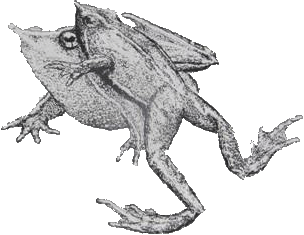
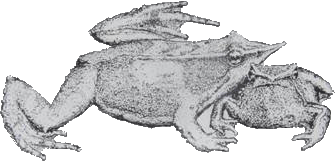
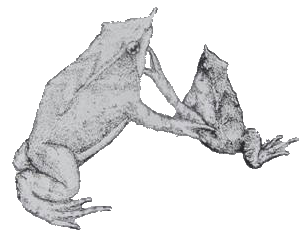
Various stages of pre-reproductive courtship and reproduction in Rhinoderma darwinii.
(All Line drawings on this page © Dr. Klaus Busse)
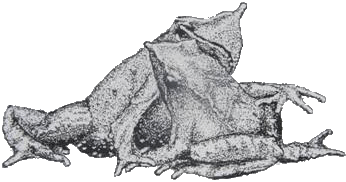
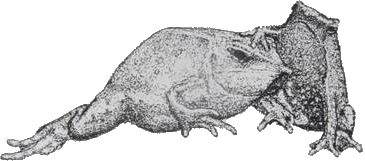
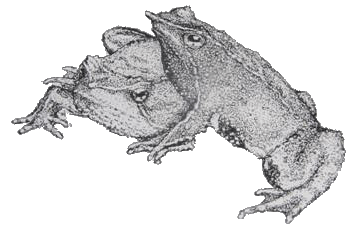
THREATS TO DARWIN'S FROGS
Rhinoderma rufum has a small known distribution and is found
only in Chile. Historically, its distribution extends from 33°30’S to 37°50’S from Curico (Curico Province) to Ramadillas (Arauco Province) at elevations of 0 to 500 meters (Stuart et al. 2008). Rhinoderma darwinii occurs in the austral forests of Chile and Argentina. In Argentina, the species is known from Neuquen and Río Negro provinces. In Chile, it ranges from the province of Concepcion south to the province of Palena. It is found from about 50 meters to 1100 meters elevation (Stuart et al. 2008).
Little is known about the physiology of the young while in the vocal sac, except that observations suggest that R. darwinii tadpoles receive nutrients from the lining of the brooding male’s vocal sac (Garrido et al., 1975; Jorquera et al., 1981). Further, little is known of how the frogs survive seasonally cold temperatures, or information regarding chemical components of their skin secretions. These all contribute to high scientific interest in this genus.
The IUCN/CBSG’s Amphibian Ark and Conservation International support the ex situ breeding of critically endangered amphibian species as a preservation tool. Because of their uniqueness, both species of Darwin’s frogs are high on the list for conservation action. Rhinoderma darwinii currently inhabits only a portion of its original known range. Some formerly dense populations have disappeared; others are much smaller (Crump, pers. comm.; Crump and Veloso, 2005; Stuart et al. 2008). There have been no confirmed reports for Rhinoderma rufum since 1978 despite attempts to find it (Stuart et al. 2008). Two key problems are believed
to be driving the decline of Darwin’s frogs. First, habitat loss plagues these species, steadily reducing both the range and numbers of Rhinoderma in the wild (Crump, 2003; IUCN Red List, 2008; Stuart et al. 2008). Destruction of native forests and replacement with non-native pine
plantations, plus forestry operations, have probably had a profound negative effect on these species. Second, the presence of an emergent infectious disease, chytridiomycosis (caused by the fungus Batrachochytrium dendrobatidis, or Bd) (Longcore et al., 1999), is suspected to have significantly contributed to the decline of these frogs as well. Our colleagues have unpublished data revealing that skin swabs taken from wild Rhinoderma in Chile have tested positive for the chytrid fungal infection (Busse, pers. comm., Fabry, pers. comm.). This fungus is responsible for the decline of many species of amphibians worldwide, has wiped out many populations, and is even responsible for the extinction of at least one species (Berger et al., 1998; Daszak et al., 1999, 2000, 2003; Muthsa et al., 2003; Mendelson et al., 2004; Rachowicz et al., 2006; Schloegel et al., 2006; Collins and Crump, 2009).
Rhinoderma darwinii is listed on the 2008 International Union for the Conservation of Nature (IUCN) Red List as Vulnerable. Rhinoderma rufum is listed as Critically Endangered on the 2008 IUCN Red List.
Continue reading about Our Plan to Combat the Demise of Darwin’s Frogs
A PROJECT OF THE |
WITH |
| All contents copyright © 2009-2019, unless otherwise noted. | |


